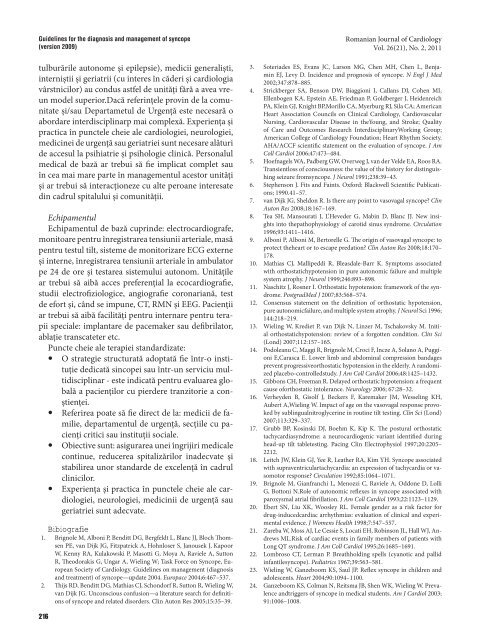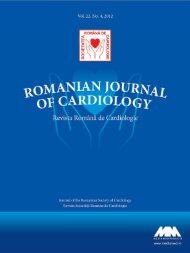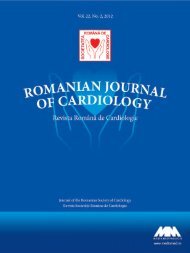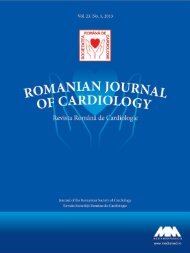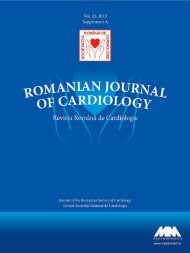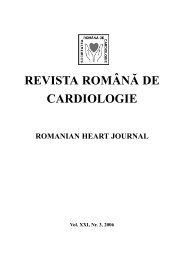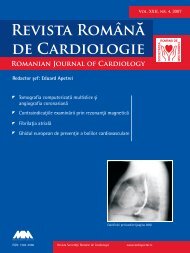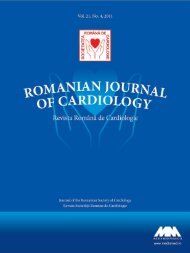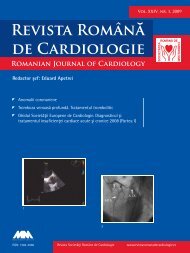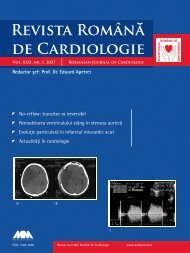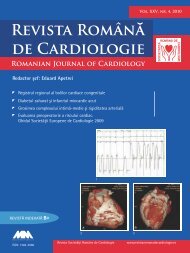Ghidul privind diagnosticul şi managementul sincopei - Romanian ...
Ghidul privind diagnosticul şi managementul sincopei - Romanian ...
Ghidul privind diagnosticul şi managementul sincopei - Romanian ...
You also want an ePaper? Increase the reach of your titles
YUMPU automatically turns print PDFs into web optimized ePapers that Google loves.
Guidelines for the diagnosis and management of syncope<br />
(version 2009)<br />
tulburările autonome și epilepsie), medicii generaliști,<br />
interniștii și geriatrii (cu interes în căderi și cardiologia<br />
vârstnicilor) au condus astfel de unităţi fără a avea vreun<br />
model superior.Dacă referinţele provin de la comunitate<br />
și/sau Departametul de Urgenţă este necesară o<br />
abordare interdisciplinarp mai complexă. Experienţa și<br />
practica în punctele cheie ale cardiologiei, neurologiei,<br />
medicinei de urgenţă sau geriatriei sunt necesare alături<br />
de accesul la psihiatrie și psihologie clinică. Personalul<br />
medical de bază ar trebui să fi e implicat complet sau<br />
în cea mai mare parte în <strong>managementul</strong> acestor unităţi<br />
și ar trebui să interacţioneze cu alte peroane interesate<br />
din cadrul spitalului și comunităţii.<br />
Echipamentul<br />
Echipamentul de bază cuprinde: electrocardiografe,<br />
monitoare pentru înregistrarea tensiunii arteriale, masă<br />
pentru testul tilt, sisteme de monitorizare ECG externe<br />
și interne, înregistrarea tensiunii arteriale în ambulator<br />
pe 24 de ore și testarea sistemului autonom. Unităţile<br />
ar trebui să aibă acces preferenţial la ecocardiografi e,<br />
studii electrofi ziologice, angiografi e coronariană, test<br />
de efort și, când se impune, CT, RMN și EEG. Pacienţii<br />
ar trebui să aibă facilităţi pentru internare pentru terapii<br />
speciale: implantare de pacemaker sau defi brilator,<br />
ablaţie transcateter etc.<br />
Puncte cheie ale terapiei standardizate:<br />
O strategie structurată adoptată fi e într-o institu<br />
ţie dedicată <strong>sincopei</strong> sau într-un serviciu multi<br />
dis ciplinar - este indicată pentru evaluarea glob<br />
a lă a pacienţilor cu pierdere tranzitorie a con -<br />
ştienţei.<br />
Referirea poate să fi e direct de la: medicii de familie,<br />
departamentul de urgenţă, secţiile cu pacienţi<br />
critici sau instituţii sociale.<br />
Obiective sunt: asigurarea unei îngrijiri medicale<br />
continue, reducerea spitalizărilor inadecvate <strong>şi</strong><br />
stabilirea unor standarde de excelenţă în cadrul<br />
clinicilor.<br />
Experienţa <strong>şi</strong> practica în punctele cheie ale cardiologiei,<br />
neurologiei, medicinii de urgenţă sau<br />
geriatriei sunt adecvate.<br />
Bibiografi e<br />
1. Brignole M, Alboni P, Benditt DG, Bergfeldt L, Blanc JJ, Bloch Th omsen<br />
PE, van Dijk JG, Fitzpatrick A, Hohnloser S, Janousek J, Kapoor<br />
W, Kenny RA, Kulakowski P, Masotti G, Moya A, Raviele A, Sutton<br />
R, Th eodorakis G, Ungar A, Wieling W; Task Force on Syncope, European<br />
Society of Cardiology. Guidelines on management (diagnosis<br />
and treatment) of syncope—update 2004. Europace 2004;6:467–537.<br />
2. Th ijs RD, Benditt DG, Mathias CJ, Schondorf R, Sutton R, Wieling W,<br />
van Dijk JG. Unconscious confusion—a literature search for defi nitions<br />
of syncope and related disorders. Clin Auton Res 2005;15:35–39.<br />
<br />
<strong>Romanian</strong> Journal of Cardiology<br />
Vol. 26(21), No. 2, 2011<br />
3. Soteriades ES, Evans JC, Larson MG, Chen MH, Chen L, Benjamin<br />
EJ, Levy D. Incidence and prognosis of syncope. N Engl J Med<br />
2002;347:878–885.<br />
4. Strickberger SA, Benson DW, Biaggioni I, Callans DJ, Cohen MI,<br />
Ellenbogen KA, Epstein AE, Friedman P, Goldberger J, Heidenreich<br />
PA, Klein GJ, Knight BP,Morillo CA, Myerburg RJ, Sila CA; American<br />
Heart Association Councils on Clinical Cardiology, Cardiovascular<br />
Nursing, Cardiovascular Disease in theYoung, and Stroke; Quality<br />
of Care and Outcomes Research InterdisciplinaryWorking Group;<br />
American College of Cardiology Foundation; Heart Rhythm Society.<br />
AHA/ACCF scientifi c statement on the evaluation of syncope. J Am<br />
Coll Cardiol 2006;47:473–484.<br />
5. Hoefnagels WA, Padberg GW, Overweg J, van der Velde EA, Roos RA.<br />
Transientloss of consciousness: the value of the history for distinguishing<br />
seizure fromsyncope. J Neurol 1991;238:39–43.<br />
6. Stephenson J. Fits and Faints. Oxford: Blackwell Scientifi c Publications;<br />
1990.41–57.<br />
7. van Dijk JG, Sheldon R. Is there any point to vasovagal syncope? Clin<br />
Auton Res 2008;18:167–169.<br />
8. Tea SH, Mansourati J, L’Heveder G, Mabin D, Blanc JJ. New insights<br />
into thepathophysiology of carotid sinus syndrome. Circulation<br />
1996;93:1411–1416.<br />
9. Alboni P, Alboni M, Bertorelle G. Th e origin of vasovagal syncope: to<br />
protect theheart or to escape predation? Clin Auton Res 2008;18:170–<br />
178.<br />
10. Mathias CJ, Mallipeddi R, Bleasdale-Barr K. Symptoms associated<br />
with orthostatichypotension in pure autonomic failure and multiple<br />
system atrophy. J Neurol 1999;246:893–898.<br />
11. Naschitz J, Rosner I. Orthostatic hypotension: framework of the syndrome.<br />
PostgradMed J 2007;83:568–574.<br />
12. Consensus statement on the defi nition of orthostatic hypotension,<br />
pure autonomicfailure, and multiple system atrophy. J Neurol Sci 1996;<br />
144:218–219.<br />
13. Wieling W, Krediet P, van Dijk N, Linzer M, Tschakovsky M. Initial<br />
orthostatichypotension: review of a forgotten condition. Clin Sci<br />
(Lond) 2007;112:157–165.<br />
14. Podoleanu C, Maggi R, Brignole M, Croci F, Incze A, Solano A, Puggioni<br />
E,Carasca E. Lower limb and abdominal compression bandages<br />
prevent progressiveorthostatic hypotension in the elderly. A randomized<br />
placebo-controlledstudy. J Am Coll Cardiol 2006;48:1425–1432.<br />
15. Gibbons CH, Freeman R. Delayed orthostatic hypotension: a frequent<br />
cause oforthostatic intolerance. Neurology 2006; 67:28–32.<br />
16. Verheyden B, Gisolf J, Beckers F, Karemaker JM, Wesseling KH,<br />
Aubert A,Wieling W. Impact of age on the vasovagal response provoked<br />
by sublingualnitroglycerine in routine tilt testing. Clin Sci (Lond)<br />
2007;113:329–337.<br />
17. Grubb BP, Kosinski DJ, Boehm K, Kip K. Th e postural orthostatic<br />
tachycardiasyndrome: a neurocardiogenic variant identifi ed during<br />
head-up tilt tabletesting. Pacing Clin Electrophysiol 1997;20:2205–<br />
2212.<br />
18. Leitch JW, Klein GJ, Yee R, Leather RA, Kim YH. Syncope associated<br />
with supraventriculartachycardia: an expression of tachycardia or vasomotor<br />
response? Circulation 1992;85:1064–1071.<br />
19. Brignole M, Gianfranchi L, Menozzi C, Raviele A, Oddone D, Lolli<br />
G, Bottoni N.Role of autonomic refl exes in syncope associated with<br />
paroxysmal atrial fi brillation. J Am Coll Cardiol 1993;22:1123–1129.<br />
20. Ebert SN, Liu XK, Woosley RL. Female gender as a risk factor for<br />
drug-inducedcardiac arrhythmias: evaluation of clinical and experimental<br />
evidence. J Womens Health 1998;7:547–557.<br />
21. Zareba W, Moss AJ, Le Cessie S, Locati EH, Robinson JL, Hall WJ, Andrews<br />
ML.Risk of cardiac events in family members of patients with<br />
Long QT syndrome. J Am Coll Cardiol 1995;26:1685–1691.<br />
22. Lombroso CT, Lerman P. Breathholding spells (cyanotic and pallid<br />
infantilesyncope). Pediatrics 1967;39:563–581.<br />
23. Wieling W, Ganzeboom KS, Saul JP. Refl ex syncope in children and<br />
adolescents. Heart 2004;90:1094–1100.<br />
24. Ganzeboom KS, Colman N, Reitsma JB, Shen WK, Wieling W. Prevalence<br />
andtriggers of syncope in medical students. Am J Cardiol 2003;<br />
91:1006–1008.


